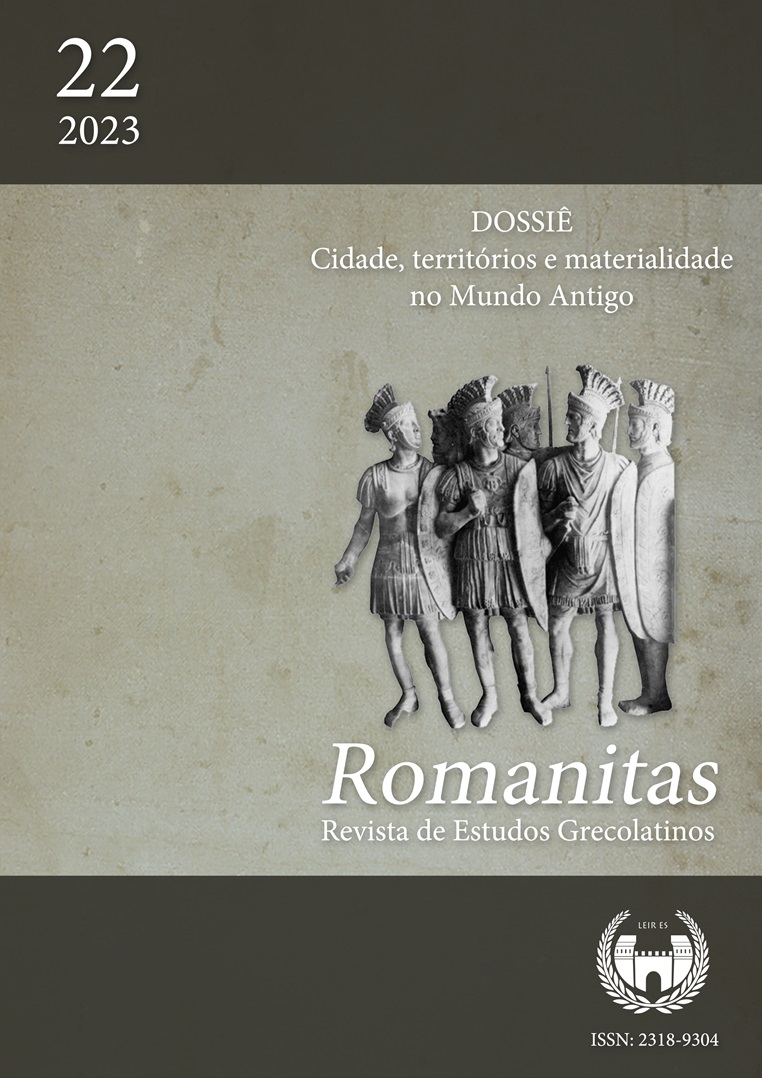O passado e o presente de Cádiz e da Turdetânia na 'Geografia' de Estrabão
reflexões sobre processos de integração
DOI:
https://doi.org/10.29327/2345891.11.22-9Palavras-chave:
Estrabão, Cádiz, Turdetânia, Romanização, IntegraçãoResumo
O processo de integração no Mediterrâneo Antigo representa um fenômeno complexo e multifacetado, cujos contornos são revelados tanto por fontes arqueológicas quanto materiais. O presente artigo tem como objetivo refletir justamente sobre esse processo a partir de uma análise da obra Geografia, de Estrabão (séc. I a.C.), descrevendo o espaço da Turdetânia e a cidade de Cádiz. Com uma leitura detalhada do livro III desta obra, pretende-se oferecer uma visão alternativa ao papel da cidade gaditana, aos olhos de Estrabão e de outras fontes escritas contemporâneas, nas transformações observadas no espaço da Turdetânia. Defende-se que, em vez de ser um paradigma para o estudo da romanização, como defendem alguns autores, tanto Cádiz quanto a Turdetânia podem ser lidas como modelos de um mundo em integração muito antes da chegada dos romanos, sendo tal cidade um agente central desse processo.
Downloads
Referências
Documentação textual
DIODORO SICULUS. Library of History. Translated by C. H. Oldfather. Cambridge: Harvard University Press, 1954.
LIVY. History of Rome: Books 1-2. Translated by B. O. Foster. Cambridge: Harvard University Press, 1919. v. 1.
PLINY, THE ELDER. Natural History. Translated by H. Rackham and W. H. S. Jones. Cambridge: Harvard University Press, 1989.
POLÍBIO. Histórias. Tradução de Mario da Gama Cury. Brasília: Editora da Universidade de Brasília, 1996.
STRABO. The Geography. Translated by Horace Leonard Jones Cambridge: Harvard University Press, 1960.
Obras de apoio
CELESTINO, S. P.; LÓPEZ-CRUZ, C. Tartessos and the Phoenicians in Iberia. Oxford: Oxford University Press, 2016.
CLARKE, K. Between Geography and History: Hellenistic constructions of the Roman world. Oxford: Oxford University Press, 1999.
CLAVEL-LEVEQUE, M. Les gaules et les gaulois: pour une analyse du fonctionnement de la géographie de Strabon. Dialogues d'Histoire Ancienne, v. 1, p. 75-93, 1974.
CRUZ ANDREOTTI, G. (ed.). Roman Turdetania. Leiden: Brill, 2018.
CRUZ ANDREOTTI, G. Rome and Iberia: The making of a cultural geography. In.: BIANCHETTI, S.; CATAUDELLA, M.; GEHRKE, H. J. (ed.). Brill’s companion to ancient geography: the inhabited world in Greek and Roman tradition. Boston: Brill, 2015, p. 274-297.
DUECK, D. Geography in Classical Antiquity. Cambridge: Cambridge University Press, 2012.
DUECK, D. Strabo of Amasia: a Greek man of letters in Augustan Rome. London: Routledge, 2002.
ESCACENA, J. L.; BELTRÁN, J. Territorio y ecosistema: la paleo desembocadura del Guadalquivir. In: GONZÁLES, M.; PIÑERO, M. A. (ed.). Arqueología del Bajo Guadalquivir: Prehistoria y Antigüedad de Las Cabezas de San Juan. Sevilla: Ayuntamiento de Las Cabezas de San Juan, 2007, p. 45-53.
GARCÍA FERNÁNDEZ, F. J. El poblamiento turdetano en el Bajo Guadalquivir. Tesis (Doctoramiento em Arqueología) – Departamento de Prehistoria y Arqueología de la Universidad de Sevilla, Sevilla, 2003.
LASSERRE, F.; AUJAC, G. Introduction de la Geographie de Strabon. Paris: Les Belles Lettres, 1969.
MALKIN, I. A small Greek world. Oxford: Oxford University Press, 2011.
MIERSE, W. E. Temples and sanctuaries from the early Iron Age Levant: Recovery after collapse. Winona Lake: Eisenbrauns, 2012.
MIERSE, W. E. The architecture of the lost Temple of Hercules Gaditanus and its Levantine associations. American Journal of Archaeology, v. 108, n. 4, p. 545-575, 2004.
NICOLET, C. Space, geography, and politics in the Early Roman Empire. Ann Arbor: The University of Michigan Press, 1991.
POTHECARY, S. Strabo the Geographer: his name and its meaning. Mnemosyne, v. 52, n. 6, p. 691-704, 1999.
POTHECARY, S. Strabo, the Tiberian author: past, present and silence in Strabo's Geography. Mnemosyne, v. 55, n. 4, p. 387-438, 2002.
POTHECARY, S. The expression “our times” in Strabo’s Geography. Classical Philology, v. 92, v. 3, p. 235-246, 1997.
PRONTERA, F. Strabone e la tradizione dela Geografia Ellenistica. In.: ANDREOTTI, G.; LE ROUX, P.; MONET, P. (ed.). La invención de una geografía de la Península Ibérica: la época imperial. Madrid: CEDMA, 2007. v. 2.
SILVA, B. S. Entre o Atlântico e o Mediterrâneo: os processos de integração na Turdetânia ao final do primeiro milênio A.C. Tese (Doutorado em História Social) – Programa de Pós-Graduação em História da Universidade de São Paulo, São Paulo, 2019.
SILVA, B. S. Um espaço em foco: debate acerca dos estudos sobre a urbanização da Turdetânia. Revista do Museu de Arqueologia e Etnologia, v. 38, p. 44-60, 2022.
SILVA, B. S. Estrabão e as Províncias da Gália e da Ibéria: um estudo sobre a Geografia e o Império Romano. Dissertação (Mestrado em História Social) – Programa de Pós-Graduação em História da Universidade de São Paulo, São Paulo, 2013.
THOMPSON, L. A. Strabo on civilization. Platon, n. 31, 213-229, 1979.
Downloads
Publicado
Como Citar
Edição
Seção
Licença
Copyright (c) 2023 Bruno dos Santos Silva

Este trabalho está licenciado sob uma licença Creative Commons Attribution-NonCommercial-NoDerivatives 4.0 International License.
a. Os autores mantêm os direitos autorais e concedem à revista o direito de primeira publicação.
b. Os autores têm autorização para assumir contratos adicionais separadamente, para distribuição não-exclusiva da versão do trabalho publicada nesta revista (ex.: publicar em repositório institucional ou como capítulo de livro), com reconhecimento de autoria e publicação inicial nesta revista.
c. Autores têm permissão e são estimulados a publicar e distribuir seu trabalho online (ex.: em repositórios institucionais ou na sua página pessoal) após a primeira publicação pela revista, com os devidos créditos.
d. Os textos da revista estão licenciados com uma Licença CC BY 4.0 Deed Atribuição 4.0 Internacional (CC BY).




























